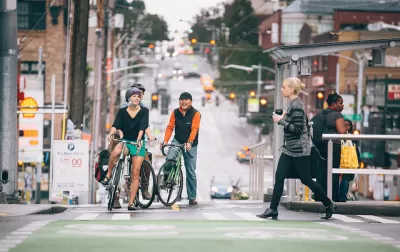The city of Seattle is working on a plan to create a zero-emissions zone to mitigate urban pollution and reduce carbon emissions in dense, congested parts of the city.

In order to meet its commitment to the C40 Fossil-Fuel-Free Streets Declaration, Seattle has released a memo draft that outlines the city's plan to implement an emissions-free zone, reports Ryan Packer for The Urbanist.
While many details of the proposal are redacted, the memo mentions two strategies that the city plans to implement, says Packer: "utilizing street space in commercial business districts (like with the Ballard Avenue cafe street or The Patio common restaurant seating area in Columbia City) and designating residential streets local-access-only with the Stay Healthy Streets program and the Home Zone pilots programs."
Seattle first signed on to the C40 pledge in 2017, one of 12 cities to do so at the time. Strategies employed by other cities include cordon pricing for vehicles entering central zones, pedestrianizing streets, and improving bike and pedestrian infrastructure. On its website, the C40 calls low-emission zones (LEZs) "a way for cities to take ambitious action more quickly in a priority area," letting cities expand the programs as results become apparent.
Planetizen has previously covered plans for zero-emissions neighborhoods in Santa Monica, where a designated zero-emissions delivery zone gives priority access to clean vehicles, and Bergen, which plans to transform a former shipping district to a 'regenerative' car-free zone that relies on low-impact mobility and access to the city's public transit system.
FULL STORY: Four Years Later, Seattle Emissions-Free Area Has Gone From Promise to Draft Plan

Alabama: Trump Terminates Settlements for Black Communities Harmed By Raw Sewage
Trump deemed the landmark civil rights agreement “illegal DEI and environmental justice policy.”

Planetizen Federal Action Tracker
A weekly monitor of how Trump’s orders and actions are impacting planners and planning in America.

The 120 Year Old Tiny Home Villages That Sheltered San Francisco’s Earthquake Refugees
More than a century ago, San Francisco mobilized to house thousands of residents displaced by the 1906 earthquake. Could their strategy offer a model for the present?

Safe Streets Grants: What to Know
This year’s round of Safe Streets for All grant criteria come with some changes.

Rural Missouri Transit Service Could Lose State Funding
OATS Transit offers low-cost rides to primarily elderly rural residents with little or no access to other transportation options.

Opinion: California’s SB 79 Would Improve Housing Affordability and Transit Access
A proposed bill would legalize transit-oriented development statewide.
Urban Design for Planners 1: Software Tools
This six-course series explores essential urban design concepts using open source software and equips planners with the tools they need to participate fully in the urban design process.
Planning for Universal Design
Learn the tools for implementing Universal Design in planning regulations.
Clanton & Associates, Inc.
Jessamine County Fiscal Court
Institute for Housing and Urban Development Studies (IHS)
City of Grandview
Harvard GSD Executive Education
Toledo-Lucas County Plan Commissions
Salt Lake City
NYU Wagner Graduate School of Public Service





























